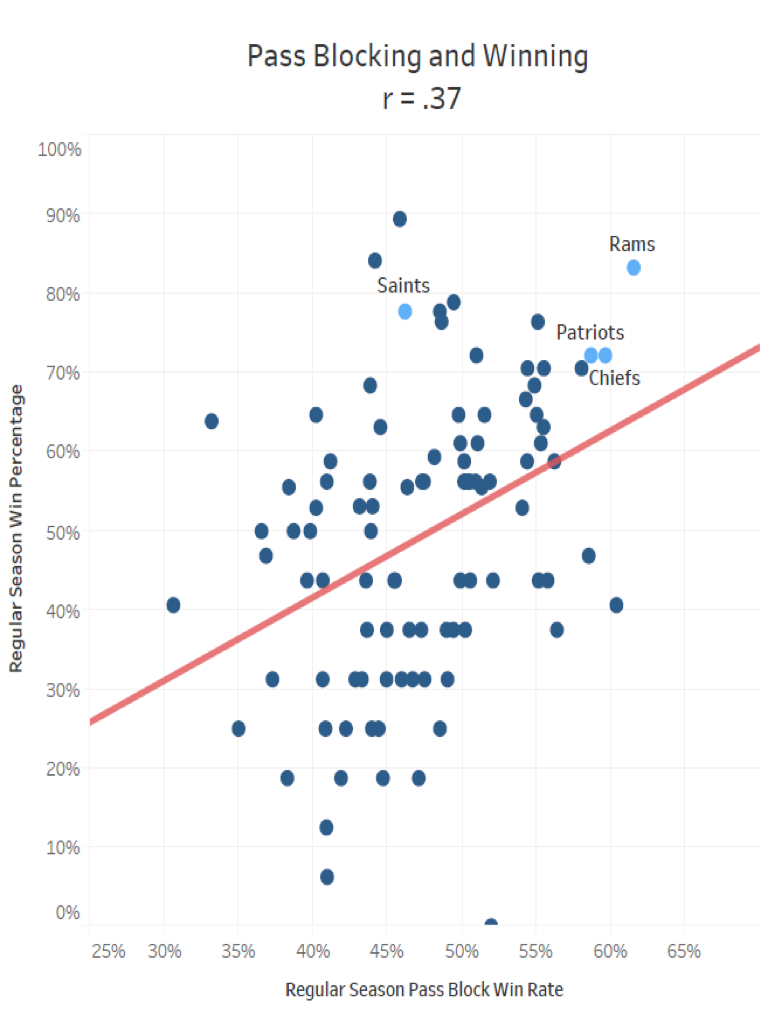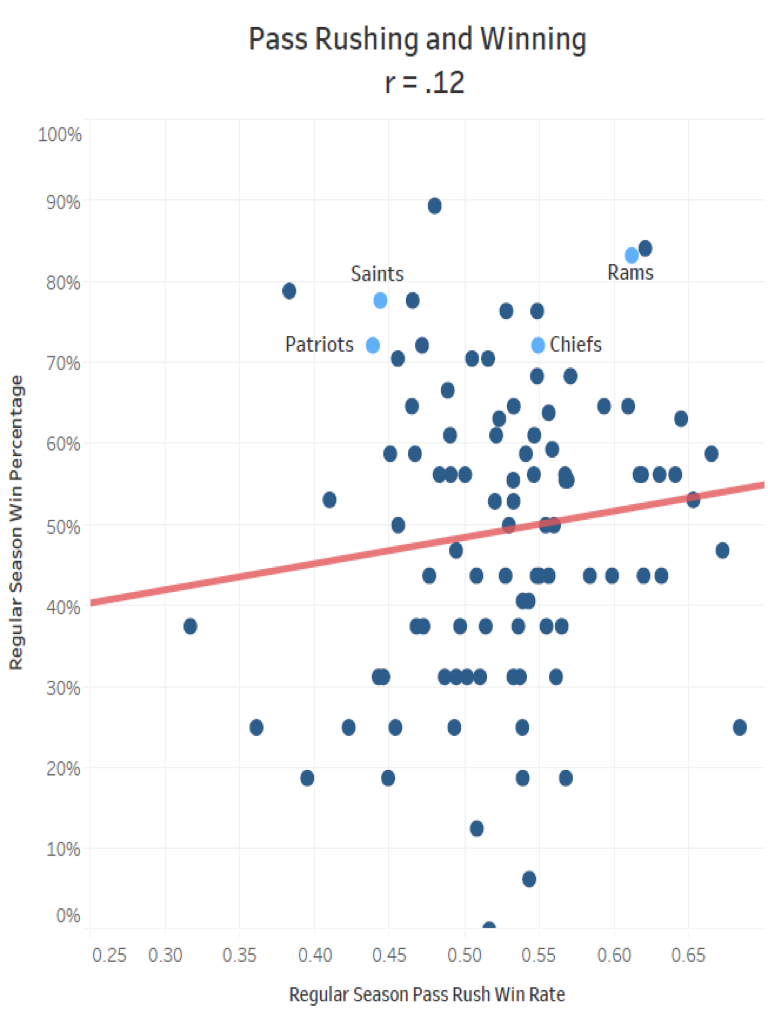
Pass blocking matters more than pass rushing, and we can prove it
You’re the general manager of an NFL franchise and have been presented with a choice. You can have the best pass-blocking offensive line in the league, or the best pass-rushing defensive line. What would you choose?
Conventional wisdom would probably make you lean toward the pass-rushers. When it comes to the trenches, that’s where the stars are. And this last draft class featured five defensive linemen or outside linebackers — including three in the first four picks — before the first offensive lineman was selected.
But the numbers? They’re screaming in the opposite direction. According to the statistics, pass blocking is more important than pass rushing. Let me explain by answering all of the questions you might have, and here are some lines to watch this season based on our pass-blocking metrics.
Wait, offensive linemen don’t really get stats. How are we even quantifying their performance?
Last season, ESPN created a new statistic to measure individual and team pass-blocking performance. It’s called pass block win rate (PBWR).
In short, if a player sustains his block for 2.5 seconds, the offense is credited with a win. If a blocker is beat before 2.5 seconds after the snap, it’s a loss. And the percentage of the time the offensive blockers win is the pass block win rate.
We even have the same statistic for the defense: pass rush win rate (PRWR). We use 2.5 seconds because it is roughly the average time to pass in the NFL.
Here’s a leaderboard for both of those statistics on the team and individual levels.
Is someone charting every play to create those numbers?
No, PBWR and PRWR are powered by NFL Next Gen Stats. That’s the player ing data from the NFL that comes from chips in every player’s shoulder pads. So the position of those chips is what informs our metrics. This also means that every play is measured in the same, objective way.
OK. So what makes pass blocking more important?
In a sentence, teams that blocked well won more than teams that rushed the passer well.
In a given game from 2016-2018, the team with the better season-long PBWR won 60 percent of the time, while the team with the better PRWR won 52 percent of the time (including games played after the contest in question, though only in that season).
And blocking had a stronger correlation to offensive strength than pass rushing did to defensive strength.
Can you give an example?
Eight of the top 12 regular-season PBWR teams reached the playoffs. None of the bottom 12 regular-season PBWR teams did. And three of the four conference finalists — the Rams, Chiefs and Patriots — ranked in the top four in PBWR.

The correlation between pass block win rate and winning over the last three seasons. Three of the four conference finalists in 2018 finished the regular season ranked in the top four in pass block win rate.
For pass rushing, at least by eyeballing it, the same patterns don’t exactly pop out. The Panthers, Rams, Dolphins, Eagles and Bills rounded out the top five. The Super Bowl champion Patriots ranked in the bottom five, and former Patriots defensive coordinator Matt Patricia led the Lions to a dead-last PRWR ranking.

Pass rush win rate is noticeably less correlated with winning over the last three seasons than pass block win rate is over the same span.
Jump to the bottom to see full rankings for PBWR and PRWR for all 32 NFL teams.
Those are just anecdotes, though, right?
Yes, but we did also take a broader look.
Over the past three seasons, team PBWR correlated with team win percentage at almost the same rate that all of defensive production (defensive expected points added per play) did with team win percentage (correlation: 0.4). In other words, in terms of winning games, it appears that each team’s pass blocking alone is almost as important as its entire defensive performance.
In 2018, the correlation was strongest: PBWR’s correlation with win percentage surpassed defensive EPA/P’s correlation with win percentage.
Can you put that in football terms?
Let’s say the Patriots are playing the Texans. New England had one of the best pass-blocking units in the league last season. And the Texans had J.J. Watt and Jadeveon Clowney leading the charge on the other side.
Even though our numbers recognize Watt and Clowney as high-end pass-rushers, we’d guess the edge in the matchup in the trenches would still go to the Patriots. At least based on the correlations, it seems that good pass blocking is more indicative of success than good pass rushing. It’s not that dissimilar of a theory to one recently posited by Pro Football Focus, that pass coverage is more important than pass rushing.
Even if we accept that pass blocking is more important than pass rushing, do we have any idea why that is?
One idea is that the offense has the advantage because it can dictate the length of the play more than the defense. If a quarterback is under pressure or anticipates being under pressure, he can get rid of the ball quickly, mitigating the effect of strong pass-rushers.
Meanwhile, the defense can blitz extra rushers to manufacture pressure or pass rush wins, but that choice generally must be made pre-snap, and it comes with a heavy cost: fewer defenders in coverage if the ball is indeed thrown.
We should note that the numbers in this story aren’t opponent- or blitz-adjusted, although that’s something we could look into in the future.
Is it possible that pass blocking correlates with winning but doesn’t cause winning?
It’s possible, but we don’t think that’s the case. The fear is that is might be similar to the problem with rushing attempts. Rushing attempts correlate with winning, but not because running the ball more means teams will win more. Teams that win more are winning at the end of the game, and therefore are running out the clock.
Initially, we had some concern about that. Teams that are losing, for example, find themselves in must-pass situations. That might make it more difficult to pass block because opponents aren’t kept honest by the threat of the run, and that could explain why worse teams have worse PBWRs. However, if that were true, we would also expect winning teams to have better PRWRs, and that isn’t true to nearly the degree that it is with pass blocking.
Is either pass blocking or pass rushing more stable than the other?
As far as we’ve seen, not really. We looked at both a week-to-week correlation and a comparison of the first half of the season to the second half of the season for PBWR and PRWR. In both cases, PRWR had a barely stronger correlation, but not by a meaningful amount. So based on that, they seem to be about equally stable.
Is it possible they are equally as important then?
We don’t think so. Even if they are equally stable, the value of the pass blocking seems to be higher due to its stronger correlation with offensive success.
And that’s not only true looking back. In 2018, there was significant correlation between a team’s PBWR in the first half of the season to its offensive success in the second half of the season, and much more so than for PRWR.
However, there was hardly any correlation between PBWR and offensive success in 2016-17.
Hang on a second. This is the second time you’ve separated out 2018 to highlight a more exciting result. Why would you reduce the sample like that?
Actually, there may be good reason. Between 2017 and 2018, Zebra Technologies (the NFL’s player ing provider) made improvements to player orientation in the ing data. We don’t know for sure, but we strongly suspect that that resulted in improvements in our pass-blocking and pass-rushing metrics.
But yes, maybe 2018 was just a variance blip. It’s one of the intriguing elements at play here in that we just don’t know fully know and will continue keeping an eye on our results going forward.
Let’s go back to pass blocking and pass rushing. So if we accept that pass blocking is more important than pass rushing, does that mean GMs should be paying the best offensive linemen more than the best defensive linemen?
In my opinion, on the offensive line, it’s more critical to avoid a particularly poor weak blocker than to have a particularly strong best blocker. Think of pass protection like a chain. The weakest link will cause it to break the quickest, no matter how strong any one particular link might be. And the reverse is true for defense. It may take only one defender breaking through to wreak havoc on an opposing quarterback.
If we assume that concept to be true, it still remains possible that a single elite pass-rusher could be more valuable than a single elite pass-blocker. If I were a GM, I’d invest heavily in the offensive line as a group, but with that investment spread over many players rather than concentrated in a few. If we’re working off the weak link theory, then depth is critical. Few teams will finish a season with the same offensive line it started with.
OK, so coming full circle, is it better to have the best offensive line or best defensive line in the NFL?
On this, the results are more clear. It’s better to have the best offensive line. It just matters more. Given the attention and accolades that pass-rushers receive, this is somewhat surprising. But offenses across the league have a wider distribution of skill than defenses. This means that the best offenses tend to outperform the top defenses.
When in doubt in team building, it makes sense to lean toward the offense where an advantage is leveraged the most. And along the line of scrimmage is no different. Good pass blocking bests good pass rushing.
Team-by-team PBWR and PRWR breakdowns
Brian Burke, Matt Morris and Kevin Seifert all contributed to this article.
Follow us on Twitter
Original Source
